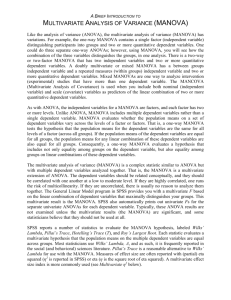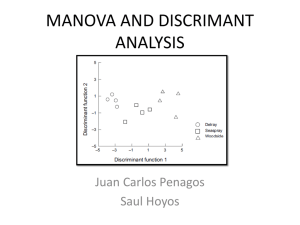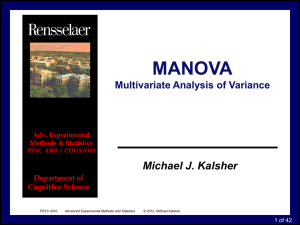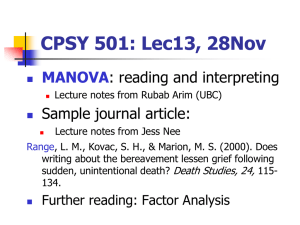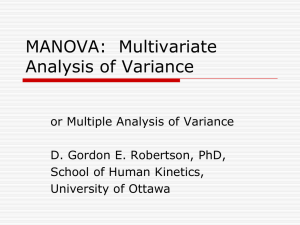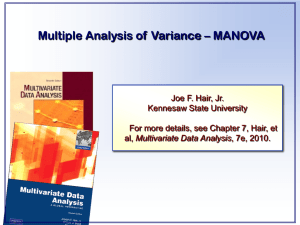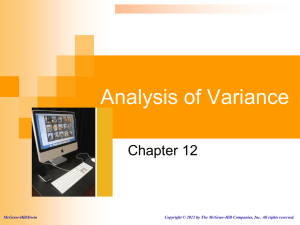One-Way Manova
advertisement
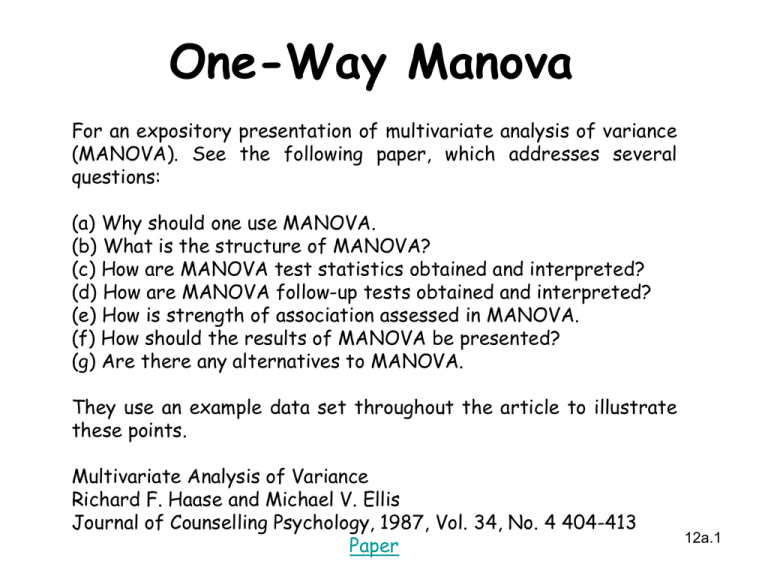
One-Way Manova For an expository presentation of multivariate analysis of variance (MANOVA). See the following paper, which addresses several questions: (a) Why should one use MANOVA. (b) What is the structure of MANOVA? (c) How are MANOVA test statistics obtained and interpreted? (d) How are MANOVA follow-up tests obtained and interpreted? (e) How is strength of association assessed in MANOVA. (f) How should the results of MANOVA be presented? (g) Are there any alternatives to MANOVA. They use an example data set throughout the article to illustrate these points. Multivariate Analysis of Variance Richard F. Haase and Michael V. Ellis Journal of Counselling Psychology, 1987, Vol. 34, No. 4 404-413 Paper 12a.1 One-Way Manova The data used in this example are from the following experiment. A researcher randomly assigns 33 subjects to one of three groups. The first group receives technical dietary information interactively from an on-line website. Group 2 receives the same information from a nurse practitioner, while group 3 receives the information from a video tape made by the same nurse practitioner. 12a.2 2 One-Way Manova Each subject then made three ratings: difficulty, usefulness, and importance of the information in the presentation. The researcher looks at three different ratings of the presentation (difficulty, usefulness and importance) to determine if there is a difference in the modes of presentation. In particular, the researcher is interested in whether the interactive website is superior because that is the most cost-effective way of delivering the information. In the dataset, the ratings are presented in the variables useful, difficulty and importance. The variable group indicates the group to which a subject was 12a.3 3 assigned. One-Way Manova We are interested in how the variability in the three ratings can be explained by a subject's group. Group is a categorical variable with three possible values: 1, 2 or 3. Because we have multiple dependent variables that cannot be combined, we will choose to use manova. Our null hypothesis in this analysis is that a subject's group has no effect on any of the three different ratings, and we can test this hypothesis on the dataset. 12a.4 4 One-Way Manova We can start by examining the three outcome variables. Variable Position GROUP 1 Measurement Level Nominal 1 receives technical dietary information interactively from an online website. 2 receives the same information from a nurse practitioner 3 receives the information from a video tape made by the same nurse practitioner USEFUL 2 Scale DIFFICULTY 3 Scale IMPORTANCE 4 Scale 12a.5 5 One-Way Manova Next, we can enter our manova command. In SPSS, manova can be conducted through the generalized linear model function, GLM. In the manova command, we first list the outcome variables, then indicate any categorical factors after "by" and any covariates after "with". Here, group is a categorical factor. We must also indicate the lowest and highest values found in group. We are also asking SPSS to print the eigenvalues generated. These will be useful in seeing how the test statistics are calculated. 12a.6 6 One-Way Manova manova useful difficulty importance by group(1,3) /print=sig(eigen). Manova -----------------------------------------------------------The default error term in MANOVA has been changed from WITHIN CELLS to WITHIN+RESIDUAL. Note that these are the same for all full factorial designs. *****************Analysis of Va riance***************** 33 cases accepted. 0 cases rejected because of out-of-range factor values. 0 cases rejected because of missing data. 3 non-empty cells. 1 design will be processed. Currently the command is only available in the Advanced Statistics addon module. -----------------------------------------------------------* * * * * * * * * * * * * * * * * A n a l y s i s o f V a r i a n c e -- Design 1 * * * * * * * * * * * * * * * * * EFFECT .. GROUP Multivariate Tests of Significance (S = 2, M = 0, N = 13 ) Test Name Value Approx. F Hypoth. DF Pillais .47667 3.02483 6.00 Hotellings .89723 4.03753 6.00 Wilks .52579 3.53823 6.00 Roys .47146 Note.. F statistic for WILKS' Lambda is exact. Error DF 58.00 54.00 56.00 Sig. of F .012 .002 .005 -----------------------------------------------------------Eigenvalues and Canonical Correlations Root No. 1 2 Eigenvalue .89199 .00524 Pct. Cum. Pct. 99.41575 99.41575 .58425 100.00000 Canon Cor. .68663 .07221 -----------------------------------------------------------EFFECT .. GROUP (Cont.) Univariate F-tests with (2,30) D. F. Variable USEFUL DIFFICUL IMPORTAN Hypoth. SS Error SS Hypoth. MS 52.92424 293.96544 3.97515 126.28728 81.82969 426.37090 26.46212 1.98758 40.91485 Error MS 9.79885 4.20958 14.21236 F 2.70053 .47216 2.87882 -----------------------------------------------------------Abbreviated Extended Name Name DIFFICUL DIFFICULTY IMPORTAN IMPORTANCE Sig. of F .083 .628 .072 Alternately it may be accessed via the Syntax box within which the desired commands are entered directly as plain text. Alternately employ a GLM and ignore the intercept information! 12a.7 7 One-Way Manova Case summary - This provides counts of the observations to be included in the manova and the counts of observations to be dropped due to missing data or data that falls out-ofrange. 33 cases accepted. 0 cases rejected because of out-of-range factor values. 0 cases rejected because of missing data. 3 non-empty cells. 1 design will be processed. 12a.8 8 One-Way Manova Effect - This indicates the predictor variable in question. In our model, we are looking at the effect of group. EFFECT .. GROUP Multivariate Tests of Significance (S = 2, M = 0, N = 13 ) Test Name Value Approx. F Pillais .47667 3.02483 Hotellings .89723 4.03753 Wilks .52579 3.53823 Roys .47146 Note.. F statistic for WILKS' Lambda is exact. Hypoth. DF Error DF Sig. of F 6.00 6.00 6.00 58.00 54.00 56.00 .012 .002 .005 12a.9 9 One-Way Manova Value - This is the test statistic for the given effect and multivariate statistic listed in the prior column. For each predictor variable, SPSS calculates four test statistics. All of these test statistics are calculated using the eigenvalues of the model. EFFECT .. GROUP Multivariate Tests of Significance (S = 2, M = 0, N = 13 ) Test Name Value Approx. F Pillais .47667 3.02483 Hotellings .89723 4.03753 Wilks .52579 3.53823 Roys .47146 Note.. F statistic for WILKS' Lambda is exact. Hypoth. DF Error DF Sig. of F 6.00 6.00 6.00 58.00 54.00 56.00 .012 .002 .005 12a.10 10 One-Way Manova Approx. F - This is the approximate F statistic for the given effect and test statistic. EFFECT .. GROUP Multivariate Tests of Significance (S = 2, M = 0, N = 13 ) Test Name Value Approx. F Pillais .47667 3.02483 Hotellings .89723 4.03753 Wilks .52579 3.53823 Roys .47146 Note.. F statistic for WILKS' Lambda is exact. Hypoth. DF Error DF Sig. of F 6.00 6.00 6.00 58.00 54.00 56.00 .012 .002 .005 12a.11 11 One-Way Manova Hypoth. DF - This is the number of degrees of freedom in the model. EFFECT .. GROUP Multivariate Tests of Significance (S = 2, M = 0, N = 13 ) Test Name Value Approx. F Pillais .47667 3.02483 Hotellings .89723 4.03753 Wilks .52579 3.53823 Roys .47146 Note.. F statistic for WILKS' Lambda is exact. Hypoth. DF Error DF Sig. of F 6.00 6.00 6.00 58.00 54.00 56.00 .012 .002 .005 12a.12 12 One-Way Manova Error DF - This is the number of degrees of freedom associated with the model errors. There are instances in manova when the degrees of freedom may be a non-integer. EFFECT .. GROUP Multivariate Tests of Significance (S = 2, M = 0, N = 13 ) Test Name Value Approx. F Pillais .47667 3.02483 Hotellings .89723 4.03753 Wilks .52579 3.53823 Roys .47146 Note.. F statistic for WILKS' Lambda is exact. Hypoth. DF Error DF Sig. of F 6.00 6.00 6.00 58.00 54.00 56.00 .012 .002 .005 12a.13 13 One-Way Manova Sig. of F - This is the p-value associated with the F statistic and the hypothesis and error degrees of freedom of a given effect and test statistic. The null hypothesis that a given predictor has no effect on either of the outcomes is evaluated with regard to this p-value. For a given alpha level, if the p-value is less than alpha, the null hypothesis is rejected. If not, then we fail to reject the null hypothesis. In this example, we reject the null hypothesis that group has no effect on the three different ratings at alpha level .05 because the p-values are all less than .05. EFFECT .. GROUP Multivariate Tests of Significance (S = 2, M = 0, N = 13 ) Test Name Value Approx. F Pillais .47667 3.02483 Hotellings .89723 4.03753 Wilks .52579 3.53823 Roys .47146 Note.. F statistic for WILKS' Lambda is exact. Hypoth. DF Error DF Sig. of F 6.00 6.00 6.00 58.00 54.00 56.00 .012 .002 .005 12a.14 14 One-Way Manova Pillais - This is Pillai's Trace, one of the four multivariate criteria test statistics used in manova. We can calculate Pillai's trace using the generated eigenvalues. Divide each eigenvalue by (1 + the eigenvalue), then sum these ratios. So in this example, you would first calculate 0.89198790/(1+0.89198790) = 0.471455394, 0.00524207/(1+0.00524207) = 0.005214734, and 0/(1+0)=0. When these are added, we arrive at Pillai's trace: (0.471455394 + 0.005214734 + 0) = .47667. EFFECT .. GROUP Multivariate Tests of Significance (S = 2, M = 0, N = 13 ) Test Name Value Approx. F Pillais .47667 3.02483 Hotellings .89723 4.03753 Wilks .52579 3.53823 Roys .47146 Note.. F statistic for WILKS' Lambda is exact. Hypoth. DF Error DF Sig. of F 6.00 6.00 6.00 58.00 54.00 56.00 .012 .002 .005 12a.15 15 One-Way Manova Hotellings - This is Lawley-Hotelling's Trace. It is very similar to Pillai's Trace. It is the sum of the eigenvalues and is a direct generalization of the F statistic in ANOVA. We can calculate the Hotelling-Lawley Trace by summing the characteristic roots listed in the output: 0.8919879 + 0.00524207 + 0 = 0.89723. EFFECT .. GROUP Multivariate Tests of Significance (S = 2, M = 0, N = 13 ) Test Name Value Approx. F Pillais .47667 3.02483 Hotellings .89723 4.03753 Wilks .52579 3.53823 Roys .47146 Note.. F statistic for WILKS' Lambda is exact. Hypoth. DF Error DF Sig. of F 6.00 6.00 6.00 58.00 54.00 56.00 .012 .002 .005 12a.16 16 One-Way Manova Wilks - This is Wilk's Lambda. This can be interpreted as the proportion of the variance in the outcomes that is not explained by an effect. To calculate Wilks' Lambda, for each eigenvalue, calculate 1/(1 + the eigenvalue), then find the product of these ratios. So in this example, you would first calculate 1/(1+0.8919879) = 0.5285446, 1/(1+0.00524207) = 0.9947853, and 1/(1+0)=1. Then multiply 0.5285446 * 0.9947853 * 1 = 0.52579. EFFECT .. GROUP Multivariate Tests of Significance (S = 2, M = 0, N = 13 ) Test Name Value Approx. F Pillais .47667 3.02483 Hotellings .89723 4.03753 Wilks .52579 3.53823 Roys .47146 Note.. F statistic for WILKS' Lambda is exact. Hypoth. DF Error DF Sig. of F 6.00 6.00 6.00 58.00 54.00 56.00 .012 .002 .005 12a.17 17 One-Way Manova Roys - This is Roy's Largest Root. We can calculate this value by dividing the largest eigenvalue by (1+largest eigenvalue). Here, the value is 0.8919879/(1+0.8919879). Because it is based only on the maximum eigenvalue, it can behave differently from the other three test statistics. In instances where the other three are not significant and Roy's is significant, the effect should be considered not significant. EFFECT .. GROUP Multivariate Tests of Significance (S = 2, M = 0, N = 13 ) Test Name Value Approx. F Pillais .47667 3.02483 Hotellings .89723 4.03753 Wilks .52579 3.53823 Roys .47146 Note.. F statistic for WILKS' Lambda is exact. Hypoth. DF Error DF Sig. of F 6.00 6.00 6.00 58.00 54.00 56.00 .012 .002 .005 12a.18 18 One-Way Manova Note - This indicates that the F statistic for Wilk's Lambda was calculated exactly. For the other test statistics, the F values are approximate (as indicated by the column heading). EFFECT .. GROUP Multivariate Tests of Significance (S = 2, M = 0, N = 13 ) Test Name Value Approx. F Pillais .47667 3.02483 Hotellings .89723 4.03753 Wilks .52579 3.53823 Roys .47146 Note.. F statistic for WILKS' Lambda is exact. Hypoth. DF Error DF Sig. of F 6.00 6.00 6.00 58.00 54.00 56.00 .012 .002 .005 12a.19 19 One-Way Manova Eigenvalues and Canonical Correlations - This section of output provides the eigenvalues from the product of the sum-of-squares matrix of the model and the sum-of-squares matrix of the errors. There is one eigenvalue for each of the three eigenvectors of the product of the model sum of squares matrix and the error sum of squares matrix, a 3x3 matrix. Because only two are listed here, we can assume the third eigenvalue is zero. These values can be used to calculate the four multivariate test statistics. Eigenvalues and Canonical Correlations Root No. 1 2 Eigenvalue Pct. Cum. Pct. Canon Cor. .89199 .00524 99.41575 .58425 99.41575 100.00000 .68663 .07221 12a.20 20 One-Way Manova Univariate F-tests - The manova procedure provides both univariate and multivariate output. This section of output provides summarized output from a one-way anova for each of the outcomes in the manova. Each row corresponds to a different one-way anova, one for each dependent variable in the manova. While the manova tested a single hypothesis, each line in this output corresponds to a test of a different hypothesis. Generally, if your manova suggests that an effect is significant, you would expect at least one of these one-way anova tests to indicate that the effect is significant on a single outcome. EFFECT .. GROUP (Cont.) Univariate F-tests with (2,30) D. F. Variable USEFUL DIFFICUL IMPORTAN Hypoth. SS Error SS Hypoth. MS Error MS F Sig. of F 52.92424 3.97515 81.82969 293.96544 126.28728 426.37090 26.46212 1.98758 40.91485 9.79885 4.20958 14.21236 2.70053 .47216 2.87882 .083 .628 .072 12a.21 21 One-Way Manova Discriminant analysis is just the inverse of a oneway MANOVA, the multivariate analysis of variance. The levels of the independent variable (or factor) for Manova become the categories of the dependent variable for discriminant analysis, and the dependent variables of the Manova become the predictors for discriminant analysis. 12a.22 22 One-Way Manova In MANOVA we ask whether group membership produces reliable differences on a combination of dependent variables. If the answer to that question is 'yes' then clearly that combination of variables can be used to predict group membership. Mathematically, MANOVA and discriminant analysis are the same; indeed, the SPSS MANOVA command can be used to print out the discriminant functions that are at the heart of discriminant analysis, though this is not usually the easiest way of obtaining them. 12a.23 23
